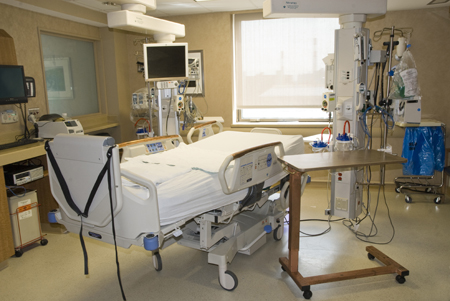Copper’s stature as an antimicrobial material is growing rapidly. Some of the results of recent groundbreaking hospital trials, presented at WHO’s International Infection Control Conference, show its usefulness in reducing HCAIs.
At the First International Conference on Prevention and Infection Control (ICPIC) held in Geneva and organised by the World Health Organisation (WHO) to share knowledge and best practice about how to fight the global problem of healthcare-associated infections (HCAIs), the majority of presentations focused on hand hygiene. The event also coincided with Semmelweis Day, celebrating the Hungarian physician who was an early pioneer of hand disinfection and other antiseptic procedures.
The scale of the HCAI problem is sobering: the latest WHO report states that in European healthcare facilities, around four million infections occur every year, costing an estimated €7bn (direct costs only).1
While the importance of hand hygiene is not in dispute, there was a groundswell of opinion that the role of the environment in the transmission of HCAIs is being overlooked, and there needs to be more work done to evaluate the impact of enhanced cleaning and decontamination of environmental surfaces on patient outcomes.
In this vein, groundbreaking results from a US trial highlighted the role of the environment by demonstrating that deployment of an effective antimicrobial material on critical touch surfaces not only reduced environmental contamination, but also reduced infection rates.
Dr Michael Schmidt, professor and vice chairman of Microbiology and Immunology at the Medical University of South Carolina, has led a three-centre clinical trial of copper touch surfaces funded by the US Department of Defense, and presented initial findings at ICPIC.
The study was designed to determine the efficacy of antimicrobial copper in reducing the level of pathogens in ICUs, and whether such a reduction would translate into a lower rate of infection. Researchers at the three hospitals involved in the trial – the Memorial Sloan Kettering Cancer Center in New York, the Medical University of South Carolina and the Ralph H. Johnson VA Medical Center, both in Charleston, South Carolina – replaced commonly touched items, such as bed rails, overbed tray tables, nurse call buttons and IV poles, with antimicrobial copper versions.
In the copperised ICU room at Memorial Sloan Kettering Cancer Center, over a period of 197 weeks, the copper surfaces demonstrated a 97% reduction in surface pathogens, the same level achieved by ‘terminal’ cleaning (the regimen conducted in the US after each patient vacates a room).
When looking at comparative bioburden on the most contaminated surfaces in an ICU patient’s vicinity, assessment of the patients in copper versus non-copper ICU rooms demonstrated that the deployment of these few copper surfaces (totalling 1.5m2 per room) reduced the risk of acquiring an HCAI by more than 40% (dependent on the amount of copper surfaces; some bariatric patients, for example, were unable to use the standard-sized beds with copper rails, meaning a lower percentage of copper in their vicinity). In rooms where all six copper items remained in place for the duration of a patient’s stay, the reduction in infection rates reached 70%.2
Dr Schmidt says: “Bacteria present on ICU room surfaces are probably responsible for 35–80% of patient infections, demonstrating how critical it is to keep hospitals clean. The copper objects used in the clinical trial supplemented cleaning protocols, lowered microbial levels and resulted in a statistically significant reduction in the number of infections contracted by patients treated in those rooms.”
In Europe, the infection rate in ICUs is typically 30%,1 so it is no surprise that studies looking at tackling HCAIs in the UK also focus on these units. Contaminated pens may re-inoculate a healthcare worker’s hands after they have been washed, and this concern led the research team at University Hospitals Birmingham NHS Foundation Trust to put antimicrobial copper to the test. This study followed on from an earlier trial at the Trust’s Selly Oak site, which demonstrated significantly reduced levels of micro-organisms on copper touch surfaces on a medical ward compared with standard items made from aluminium, chrome-plate and plastic (results backed up by the US trial as well as others taking place in Germany, Chile and Japan).
In the latest study,3 staff in two busy critical care units were given the same design of pen made from either stainless steel or brass, an alloy of copper and zinc. A total of 100 pens were allocated randomly at the start of a 12.5-hour shift for use in place of the standard black pens. Contamination on each type of pen was measured and compared at the end of the 12.5 hour working shift (25 brass and 25 stainless steel pens). The study found that, at the end of the working shift, the total contamination on the brass pens was 87.3% less than on the stainless steel pens.
This led study leader Dr Anna Casey to conclude: “Our findings clearly demonstrate that the use of copper-containing pens significantly reduces the level of microbial contamination on writing instruments. Thus, copper pens may provide a tool to prevent re-inoculation of decontaminated hands.”
When considering the costs of using copper in place of other materials, it is worth noting that the difference in cost for installing copper components – door furniture, taps, overbed tables, dressing trolleys and light switches – for the original Selly Oak trial on a general medical ward was equivalent to the cost of one infection being admitted. The copper, once installed, then continues to work 24/7 for the lifetime of the product.
Copper also shares its antimicrobial efficacy with a large number of commonly used alloys, such as brasses, bronzes and copper-nickels. This means companies offering product ranges can provide a variety of colour-matching shades to suit an installation’s requirements. A bold statement of infection prevention can be provided with copper, the gold brasses give a comfortable, homely feel and copper-nickels offer a silver appearance that can resemble stainless steel.
To simplify matters for specifiers, the term ‘Antimicrobial Copper’ has been introduced through an industry stewardship scheme to cover all efficacious copper alloys. This incorporates the Cu+ mark that can be shown on copper products identifying them as such (see Figure 1).
As awareness of the latest research grows, and increasing numbers of manufacturers are offering Antimicrobial Copper ranges, more hospitals are starting to install products. The latest example is a £1m, eight-bed intensive care unit specially designed with cutting-edge infection prevention measures, which has just opened in Manchester. Door furniture in all clinical areas and work surfaces used for the preparation of medication have been made from copper.

Figure 3: Comparative bioburden on the most contaminated surfaces in an ICU room
The facility is the latest embodiment of Trafford Healthcare NHS Trust’s commit-ment to an outstanding record on HCAIs. Dr John Barnes, lead consultant in intensive care and consultant anaesthetist, explained that the new unit “will provide a modern, patient-centred service and care to our most critically-ill patients, using the latest innovations in infection prevention and control”.
A state-of-the-art Cystic Fibrosis Unit at Sheffield’s Northern General Hospital, aiming to ‘set the gold standard for infection prevention’ has also installed copper door furniture throughout in a bid to reduce the risk of healthcare-associated infections in particularly vulnerable patients.
In parallel with the adoption of the technology, work continues on elucidating the precise mechanism by which copper exerts its effect. One of the pioneers and leading experts in this field is Professor Bill Keevil, head of the Microbiology Group and Director of the Environmental Healthcare Unit at the University of Southampton. At ICPIC, he presented his latest work on how copper exerts its antimicrobial effect.
Using a new test, designed to simulate a dry touch contamination event, he saw 10 million vancomycin-resistant enterococci killed in just 10 minutes.4 Considering the more typical challenge in a hospital environment would be, for example, 1,000 bacteria per door knob, this demonstrates the substantial power of copper rapidly and continuously to reduce bioburden on its surface and thus lower the risk of bacteria or viruses being picked up from it.
The rapid nature of copper’s action also has a role to play in preventing the spread of antibiotic resistance. “As more resistant bacteria emerge, we’re running out of drugs to treat the infections they cause, so we need to do everything practicable to prevent their spread,” Professor Keevil explains. “Copper is a powerful antimicrobial that quickly and continuously reduces the number of bacteria on its surface. We’ve demonstrated it in the lab, and it’s also been shown to be effective in busy clinical environments as part of a set of infection control procedures.”
Keevil previously showed that silver-containing coatings did not work at room temperature and humidity, requiring 35°C and greater than 90% humidity for the silver to ionise and be effective. Copper, on the other hand, was shown to work not only under typical indoor conditions, but also at refrigeration temperatures. These findings have suggested a wider use for copper surfaces, beyond ICUs and even hospitals, in any public space in which people will gather and surfaces will be touched by a large number of hands, raising the risk of infections being passed between them.
In Beijing, China, antimicrobial copper-containing air conditioners have been installed on buses to investigate the improvement of air quality that can be obtained. Japan, meanwhile, has two child-care centres equipped with antimicrobial copper surfaces, and in France, a newly opened combined care home for children and the elderly also has antimicrobial copper handrails and door furniture.

Figure 4: Children at Mejiro Daycare Center in Tokyo, Japan, using brass taps at a brass sink
References
1. Report on the Burden of Endemic Health Care-Associated Infection Worldwide, World Health Organization, 2011
http://whqlibdoc.who.int/publications/2011/9789241501507_eng.pdf
2. Schmidt MG, BMC Proceedings 2011, 5 (Suppl 6): O53 (Oral presentation delivered at 1st International Conference on Prevention and Infection Control, June 29-July 2, 2011, Geneva, Switzerland)
3. Anna L Casey PhD et al, American Journal of Infection Control doi:10.1016/j.ajic.2010.12.012
http://www.sciencedirect.com/science/article/pii/S0196655311001131
4. S L Warnes and C W Keevil, Applied and Environmental Microbiology, Sept. 2011, Vol. 77, No. 17




